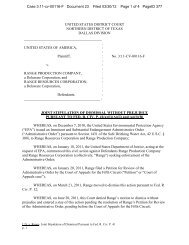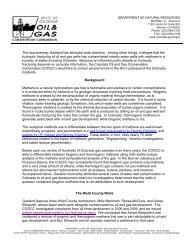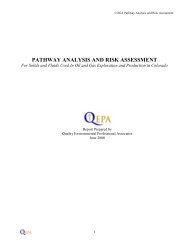IPAA Oil & Gas Producing Industry in Your State - Energy in Depth
IPAA Oil & Gas Producing Industry in Your State - Energy in Depth
IPAA Oil & Gas Producing Industry in Your State - Energy in Depth
Create successful ePaper yourself
Turn your PDF publications into a flip-book with our unique Google optimized e-Paper software.
THE YEAR IN REVIEW: INTRODUCTION TO 2006 O&G IN YOUR STATE<br />
THE YEAR IN REVIEW<br />
Newfield Exploration Company expanded its Woodford<br />
shale play <strong>in</strong> southeast Oklahoma and found that reduc<strong>in</strong>g<br />
frac <strong>in</strong>tervals to 500 feet or less generated the<br />
same ultimate gas recoveries as achieved from 1,000<br />
ft. frac stages <strong>in</strong> earlier wells. Other <strong>in</strong>dependent operators<br />
expanded the Woodford play <strong>in</strong>to the Ardmore<br />
Bas<strong>in</strong> of southern Oklahoma. Also <strong>in</strong> the mid-cont<strong>in</strong>ent<br />
region, operators tested the Caney shale <strong>in</strong> Oklahoma<br />
and the Bend shale <strong>in</strong> the Palo Duro Bas<strong>in</strong>. In the Permian<br />
Bas<strong>in</strong>, thick Woodford and Barnett shales attracted<br />
substantial <strong>in</strong>dustry <strong>in</strong>terest but economic success was<br />
not demonstrated before the end of the year. Independents<br />
also tested the Mississippian Floyd shale and<br />
Cambrian Conasauga shale <strong>in</strong> the Black Warrior Bas<strong>in</strong>,<br />
Devonian shales <strong>in</strong> the Appalachian Bas<strong>in</strong> and Delta<br />
Petroleum Corp. announced promis<strong>in</strong>g tests of Pennsylvanian<br />
Paradox shales <strong>in</strong> the Paradox Bas<strong>in</strong> of Utah.<br />
Operators also leveraged improved well completion<br />
technologies to <strong>in</strong>crease the harvest of <strong>in</strong>-place gas by<br />
downspac<strong>in</strong>g <strong>in</strong> established tight sand plays. Noteworthy<br />
were the Bossier and Cotton Valley plays <strong>in</strong> East Texas,<br />
Cretaceous Mesaverde sand plays <strong>in</strong> the Piceance,<br />
U<strong>in</strong>ta and Green River Bas<strong>in</strong>s. Also <strong>in</strong> the Green River<br />
Bas<strong>in</strong>, operators moved to 20 and 10 acre spac<strong>in</strong>g <strong>in</strong><br />
the prolific Lance formation of the P<strong>in</strong>edale Anticl<strong>in</strong>e with<br />
estimated 20 Tcf recoverable gas and at the Jonah field<br />
with estimated 7 to 10 Tcf recoverable gas. Increased<br />
well densities, though, prompted objections from environmental<br />
groups and community <strong>in</strong>terests. To address<br />
the issues, stakeholders were organized to stimulate<br />
collaborative communications and operators responded<br />
by reduc<strong>in</strong>g the environmental footpr<strong>in</strong>t by drill<strong>in</strong>g from<br />
pads, <strong>in</strong>stall<strong>in</strong>g water treatment and pipe systems, rapid<br />
restoration of disturbed surface areas, adjust<strong>in</strong>g operations<br />
to wildlife migrations and so forth. Such actions<br />
reduced the number of legal actions and allowed<br />
operators to spend more time on field operations.<br />
<strong>Gas</strong> Drill<strong>in</strong>g and Production:<br />
Dur<strong>in</strong>g 2006, U.S. natural gas well completions <strong>in</strong>creased<br />
by 13% to 30,642 wells. <strong>State</strong> level drill<strong>in</strong>g<br />
statistics tend to be too coarse to reflect the emergence<br />
of new plays but some are <strong>in</strong>dicative as <strong>in</strong> the follow<strong>in</strong>g<br />
table show<strong>in</strong>g the number of gas well completions<br />
for 2005 and 2006 with the <strong>in</strong>dicated % change:<br />
<strong>State</strong> 2005 2006 % Change Key Play<br />
AR 277 395 43% Fayetteville shale<br />
KS 851 1,215 43% Cherokee CBM<br />
PA 2,614 3,247 24% Devonian shale<br />
UT 445 649 46% Cretaceous tight sands<br />
The <strong>in</strong>creas<strong>in</strong>g value of horizontal wells to enable<br />
commercial production from certa<strong>in</strong> unconventional<br />
coalbed methane and shale reservoirs is reflected <strong>in</strong><br />
the dramatic 71% <strong>in</strong>crease <strong>in</strong> horizontal completions<br />
from 2004 through 2006. The Fayetteville play drove<br />
Arkansas horizontal drill<strong>in</strong>g from four wells dur<strong>in</strong>g<br />
2004 to 107 dur<strong>in</strong>g 2006. Oklahoma horizontal wells<br />
<strong>in</strong>creased by 381 wells dur<strong>in</strong>g 2004 to 699 wells dur<strong>in</strong>g<br />
2006 with much of the <strong>in</strong>crease <strong>in</strong> Woodford shale,<br />
Hartshorne coalbed methane and Granite Wash gas<br />
plays. The Barnett shale play drove most of the <strong>in</strong>crease<br />
<strong>in</strong> Texas horizontal wells which <strong>in</strong>creased from<br />
1,250 wells dur<strong>in</strong>g 2004 to 2,200 wells dur<strong>in</strong>g 2006.<br />
Coalbed methane plays added 557 Bcf of production<br />
– 16% of the production growth from unconventional<br />
reservoirs – from 1997 through 2006 but the rate<br />
of production growth and new drill<strong>in</strong>g slowed dur<strong>in</strong>g<br />
2006. Coalbed methane drill<strong>in</strong>g only grew by 44 wells<br />
to 6,710 total wells dur<strong>in</strong>g 2006. Drill<strong>in</strong>g <strong>in</strong>creases<br />
<strong>in</strong> the Cherokee coals of southeastern Kansas and<br />
Pennsylvanian coals <strong>in</strong> Virg<strong>in</strong>ia were offset by decreased<br />
drill<strong>in</strong>g <strong>in</strong> Powder River Bas<strong>in</strong> coalbed methane<br />
plays. As a result, U.S. coalbed methane production<br />
added only 62 Bcf to reach 1,662 Bcf dur<strong>in</strong>g 2006.<br />
Thanks <strong>in</strong> large part to the growth of onshore unconventional<br />
plays, U.S. natural gas production recovered<br />
from the hurricane impacts and added 387.2 Bcf to reach<br />
17,638 Bcf for the year – the most s<strong>in</strong>ce 2001. <strong>Gas</strong> production<br />
<strong>in</strong> Texas (+327 Bcf), Wyom<strong>in</strong>g (+109 bcf), Colorado<br />
(+97.3 Bcf), Oklahoma (+71 Bcf) and Utah (+40 Bcf) –<br />
mostly from unconventional gas plays – more than offset<br />
the decrease of 219 Bcf from Federal Offshore production.<br />
<strong>Oil</strong> Play Highlights:<br />
Two significant oil plays – Chevron’s Jack 2 test <strong>in</strong> the<br />
deepwater offshore Gulf of Mexico and the evolv<strong>in</strong>g<br />
Devonian Bakken shale oil play <strong>in</strong> the Williston Bas<strong>in</strong><br />
– dom<strong>in</strong>ated U.S. oil E&P news dur<strong>in</strong>g 2006. The<br />
Jack 2 well, a 28,500 ft. well <strong>in</strong> about 7,000 ft. of water<br />
<strong>in</strong> Walker Ridge Block 758, yielded the first successful<br />
production test of the pre-salt Lower Tertiary Wilcox<br />
reservoir. This was good news to operators of eleven<br />
other <strong>in</strong>dicated ultra-deepwater discoveries <strong>in</strong> this play.<br />
The test flowed 6,000 bopd from about 40% of the<br />
measured reservoir. Chevron and partners <strong>in</strong>dicated this<br />
test could be the key to unlock 3 to 13 billion barrels of<br />
recoverable oil from the Wilcox ultra-deepwater trend.<br />
Expansion of the Bakken shale play <strong>in</strong>to Mountrail<br />
County, ND established two sweet spots at the Parshall<br />
and Sanish fields and identified a new north – south<br />
fairway east of the Nesson Anticl<strong>in</strong>e that could boost<br />
the play <strong>in</strong>to the giant category. Horizontal wells and<br />
staged hydraulic frac technologies have unlocked the<br />
potential of the Bakken shale. As the potential of the<br />
new Bakken trend was realized the number of horizontal<br />
wells <strong>in</strong> North Dakota jumped from 150 wells dur<strong>in</strong>g<br />
2004 to 375 wells dur<strong>in</strong>g 2006. Correspond<strong>in</strong>gly, oil<br />
production <strong>in</strong> North Dakota grew from 30,142 Mb dur<strong>in</strong>g<br />
2004 to 36,763 Mb dur<strong>in</strong>g 2006. Independents EOG<br />
Resources Inc. and Whit<strong>in</strong>g <strong>Oil</strong> and <strong>Gas</strong> Corp. led the<br />
development <strong>in</strong> this important new Bakken oil play.<br />
4 AMERICA’S INDEPENDENT COMPILED BY <strong>IPAA</strong> FEBRUARY 2009










